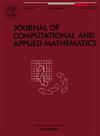Semi-discrete Lagrangian-Eulerian approach based on the weak asymptotic method for nonlocal conservation laws in several dimensions
IF 2.1
2区 数学
Q1 MATHEMATICS, APPLIED
Journal of Computational and Applied Mathematics
Pub Date : 2024-10-29
DOI:10.1016/j.cam.2024.116325
引用次数: 0
Abstract
In this work, we have expanded upon the (local) semi-discrete Lagrangian-Eulerian method initially introduced in Abreu et al. (2022) to approximate a specific class of multi-dimensional scalar conservation laws with nonlocal flux, referred to as the nonlocal model: For completeness, we analyze the convergence of this method using the weak asymptotic approach introduced in Abreu et al. (2016), with significant results extended to the multidimensional nonlocal case. While there are indeed other important techniques available that can be utilized to prove the convergence of the numerical scheme, the choice of this particular technique (weak asymptotic analysis) is quite natural. This is primarily due to its suitability for dealing with the Lagrangian-Eulerian schemes proposed in this paper. Essentially, the weak asymptotic method generates a family of approximate solutions satisfying the following properties: 1) The family of approximate functions is uniformly bounded in the space . 2) The family is dominated by a suitable temporal and spatial modulus of continuity. These properties allow us to employ the -compactness argument to extract a convergent subsequence. We demonstrate that the limit function is a weak entropy solution of Eq. (1). Finally, we present a section of numerical examples to illustrate our results. Finally, we have examined examples discussed in Aggarwal et al. (2015) and Keimer et al. (2018). In the context of the family of two-dimensional nonlocal Burgers equations, we provide numerical results for a nonlocal impact of the form , where .
基于弱渐近法的半离散拉格朗日-欧勒方法,用于若干维度的非局部守恒定律
在这项工作中,我们扩展了最初在 Abreu 等人(2022 年)中引入的(局部)半离散拉格朗日-欧勒方法,以近似具有非局部通量的一类特定多维标量守恒定律,称为非局部模型:∂tρ(t,x)+∑i=1d∂xi(Vi[W[ρ,ω](t,x)]Fi(ρ(t,x)))=0,(t,x)∈(0,T)×Rd.为完整起见,我们使用 Abreu 等人(2016)引入的弱渐近方法分析了该方法的收敛性,并将重要结果扩展到多维非局部情况。虽然确实还有其他重要技术可以用来证明数值方案的收敛性,但选择这种特定技术(弱渐近分析)是非常自然的。这主要是由于它适合处理本文提出的拉格朗日-欧拉方案。从本质上讲,弱渐近分析法生成的近似解族满足以下特性:1) 近似函数族在空间 L1(Rd)∩L∞(Rd) 中均匀有界。2) 该族由合适的连续性时空模数支配。这些性质允许我们利用 L1-紧凑性论证来提取收敛子序列。我们证明了极限函数是式 (1) 的弱熵解。最后,我们列举了部分数值示例来说明我们的结果。最后,我们研究了 Aggarwal 等人(2015 年)和 Keimer 等人(2018 年)中讨论的例子。在二维非局域布尔格斯方程组的背景下,我们提供了形式为 ωη∗ρ 的非局域影响的数值结果,其中 η=0.1.
本文章由计算机程序翻译,如有差异,请以英文原文为准。
求助全文
约1分钟内获得全文
求助全文
来源期刊
CiteScore
5.40
自引率
4.20%
发文量
437
审稿时长
3.0 months
期刊介绍:
The Journal of Computational and Applied Mathematics publishes original papers of high scientific value in all areas of computational and applied mathematics. The main interest of the Journal is in papers that describe and analyze new computational techniques for solving scientific or engineering problems. Also the improved analysis, including the effectiveness and applicability, of existing methods and algorithms is of importance. The computational efficiency (e.g. the convergence, stability, accuracy, ...) should be proved and illustrated by nontrivial numerical examples. Papers describing only variants of existing methods, without adding significant new computational properties are not of interest.
The audience consists of: applied mathematicians, numerical analysts, computational scientists and engineers.

 求助内容:
求助内容: 应助结果提醒方式:
应助结果提醒方式:


